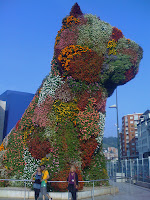



After seeing many Guggenheim Bilbao photographs and the excellent documentary by Sydney Pollack, coming upon the massive silver-colored, fish-scale-covered sculpture of interconnecting shapes was familiar and exciting. However I did not understand the scope and the magical experience until I walked inside. In the soaring halls, every surface is curved in glass and tile, transparent in all directions, relating the city to the Nervon River, the parts of the building to one another, the individual to a sense of magnificence and intentional dynamic integration.
As the third floor was closed, between installations, admission was reduced and included an audio tour, which provided valuable insights to the architecture and exhibits.
But I didn’t need any explanations to experience Richard Serra’s freestanding giant steel sculptures that fill the enormous hangar-like gallery on the first floor. Vertiginously, each draws you in, through towering curved and variously tilted metal walls, like the alleys of an ancient city, deeper and deeper until you arrive at an open space, a center. The last one (of 7 or 8 experiential pieces) has right angles, forcing you to turn directly, in contrast to flowing into the space. At the center, the metal walls form the unexpected and sensual shape of a vagina.
In an adjoining room with scale models and photographs, Serra’s installation, titled “The Matter of Time,” is described as “based on the idea of multiple or layered temporalities. The obvious diversity of durations of time are activated and animated by the viewer’s movement.”
To further illuminate, I quote from the artist: “The torqued ellipses, spirals, spheres and toruses exist in the polarity between the downward force of gravity, their weightlessness and their upward rise in elevation which attempts to attain a condition of weightlessness.
“The sculptures are not objects separated in space but on the contrary engender the spatial continuum of their environment. They impart form to the entire space, they shape the space through axes, trajectories and passages between their solids and voids.
“Meaning occurs only through continuous movement, anticipation, observation and recollection. However, there is no prescribed view, no preferred sequence, no preferred succession of views. Each person will map the space differently. There is an unlimited range of individual experiences, but they all take place over time.
“When I talk about time I do not mean ‘real time,’ clock time. The perceptual or aesthetic, emotional or psychological time of the sculptural experience is quite different from ‘real time’. It is non-narrative, discontinuous, fragmented, de-centered, disorienting.”
It’s true. It’s amazing, mind-bending, life-altering to experience the disorienting and exhilarating sense of space and time while moving between two large sheets of rusty steel. It is incomprehensible without the experience. This, I think, is the genius of Richard Serra, and also of Juan Muñoz, who I’ll write about next...to engage us in the questions and discoveries of our world and our selves.










































